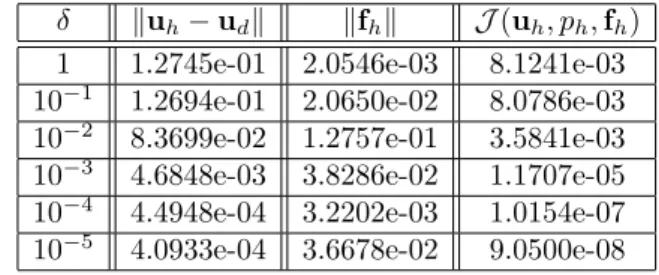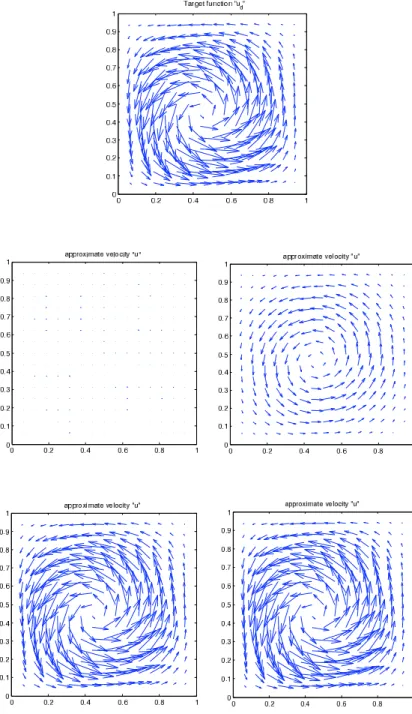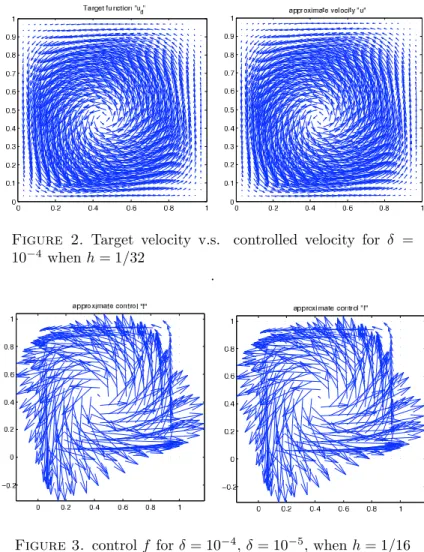DOI 10.4134/JKMS.2009.46.5.1007
ANALYSIS AND COMPUTATIONS OF LEAST-SQUARES METHOD FOR OPTIMAL CONTROL PROBLEMS FOR
THE STOKES EQUATIONS
Youngmi Choi, Sang Dong Kim, and Hyung-Chun Lee
Abstract. First-order least-squares method of a distributed optimal con- trol problem for the incompressible Stokes equations is considered. An optimality system for the optimal solution are reformulated to the equiv- alent first-order system by introducing the vorticity and then the least- squares functional corresponding to the system is defined in terms of the sum of the squared H
−1and L
2norms of the residual equations of the system. Finite element approximations are studied and optimal error es- timates are obtained. Resulting linear system of the optimality system is symmetric and positive definite. The V-cycle multigrid method is applied to the system to test computational efficiency.
1. Introduction
Recently there has been an increased interest in mathematical analyses and computations of optimal control problems for incompressible viscous flows.
Even though mathematical analysis and some computational methods were studied, the efficient and feasible numerical methods are still needed to study.
To apply the fast and stable methods in numerical algorithm, we change the unsymmetrical and indefinite system to a symmetric positive definite system using FOSLS. One of the simple problem for simple flow is to minimize the functional
(1.1) J (u, p, f ) = 1
2 ku − u d k 2 + δ 2 kf k 2 , subject to the stationary Stokes equations
−ν∆ u + ∇p = f in Ω, (1.2)
∇ · u = 0 in Ω, (1.3)
u = 0 on ∂Ω, (1.4)
Received November 29, 2007.
2000 Mathematics Subject Classification. Primary 65N30, 76D99, 49A22, 49B22.
Key words and phrases. optimal control, least-squares finite element method, multigrid method, stokes equations.
This work was supported by KRF-2005-070-C00017.
c
°2009 The Korean Mathematical Society
1007
where u d is a given desired function. Here, Ω denotes a bounded convex polyg- onal domain in R 2 or has C 1,1 boundary and u = (u 1 , u 2 ) t a candidate velocity field, p the pressure, f a prescribed forcing term and ν the viscous constant.
Assume that p satisfies the zero mean constraint, R
Ω p dx = 0. The objective of this optimal control problem is to seek a state variables u and p, and the control f which minimize the L 2 -norm distances between u and u d and satisfy (1.2)-(1.4). The second term in (1.1) is added as a limiting the cost of con- trol and the positive penalty parameter δ can be used to change the relative importance of the two terms appearing in the definition of the functional.
For this purpose, a Lagrange multiplier approach has been studied exten- sively; for example, see [2, 15, 18, 20, 21, 23, 24, 27, 28]. As a result one may have a coupled optimality system related to two Stokes type equations associated with state variables and adjoint variables. This optimality system can be dealt with mixed finite element approaches. On the other hand, with a connection with least-squares concept which has been a considerable attention in the methods of least-squares type for fluid flow problems (see for example, see [3, 4, 5, 8, 9, 10, 11, 12, 13]), one may convert the second-order optimal- ity system into the corresponding first-order system by introducing physically meaningful new dependent variables.
In this paper, using the state vorticity ω = ∇ × u of the state velocity u and the adjoint vorticity z = ∇ × v of the adjoint velocity v we reformulate the coupled second-order optimality system as the coupled first-order optimality system. These process enables us to avoid using the finite elements satisfying LBB conditions and to reduce the number of unknowns and variables of the first-order system comparing to using new flux variables. The proposed least- squares functional is consists of the L 2 and H −1 norms of residual equations of the coupled first-order system of optimality system. Then following the tech- niques in [12] the coercivity and continuity of such a functional can be shown with respect to a product norm of appropriate H 1 and L 2 norms. Because the computations of H −1 norm is not feasible, we employ the computable inner product using discrete solution operator corresponding to Dirichlet operator (see [10, 11]). Further we will use the weighted L 2 inner product to compute the H −1 inner product (see [5]). For actual computations, we use the V -cycle multigrid method with the Gauss-Seidel smooth iteration for a model problem.
By choosing a parameter, we will show several computation results.
The plan of the paper is as follows. We introduce the notation and prelim-
inary results that will be used throughout the paper in the remainder of this
section. In §2, we give a precise statement of the optimization problem and
prove that an optimal solution exists. Then we reformulate the optimality sys-
tems to the first-order system and define the L 2 and H −1 -norm least squares
functional. In §3, we obtain the optimal error estimates for least-squares finite
element method for the optimality system. Finally, In §4, some numerical tests
are performed.
1.1. Notation and preliminary results
The standard Sobolev spaces H m (Ω) and H 0 1 (Ω) will be used with the as- sociated standard inner products (·, ·) m and their respective norms k · k m . In particular, for m = 0 we replace H m (Ω) by L 2 (Ω) with the norm k · k and inner product (·, ·), and denote L 2 0 (Ω) as the subspace of square integrable functions with zero mean. For positive values of m the space H −m (Ω) is defined as the dual space of H 0 m (Ω) equipped with the norm kφk −m = sup 06=v∈Hm
0
(Ω) hφ,vi kvk
mwhere h·, ·i is the duality pairing between H −m (Ω) and H 0 m (Ω). Define the product spaces H 0 m (Ω) d = Π d i=1 H 0 m (Ω) and H −m (Ω) d = Π d i=1 H −m (Ω) with standard product norms. All subspaces are equipped with the norms inherited from the corresponding underlying spaces.
For an introduction of vorticity of the velocity u, we define the curl of v for a vector function v = (v 1 , v 2 ) t as the scalar function ∇ × v = ∂ x v 2 − ∂ y v 1 and denote by ∇ ⊥ the formal adjoint of ∇× defined by ∇ ⊥ p = (∂ y p, −∂ x p) t . Then with these notations it follows that
(1.5) ∇ ⊥ ∇ × v = −∆v + grad div v.
Because the constrained optimal control problem is the present topic of this paper, we will make a lot use of the Stokes equations. First of all we recall the H 1 regularity of the weak solutions of the Stokes equations. The weak form of the constraint equations (1.2)-(1.4) is then given as follows: seek u ∈ H 0 1 (Ω) 2 and p ∈ L 2 0 (Ω) such that
νa(u, v) + b(v, p) = hf , vi ∀v ∈ H 0 1 (Ω) 2 , (1.6)
b(u, q) = 0 ∀q ∈ L 2 0 (Ω), (1.7)
where h·, ·i is duality pairing and
a(u, v) = Z
Ω
∇u : ∇v dx, ∀u, v ∈ H 1 (Ω) 2 , b(u, q) = −
Z
Ω
q∇ · u dx ∀u ∈ H 1 (Ω) 2 , ∀q ∈ L 2 (Ω).
Then, the (weak form of the) boundary value problem (1.6)-(1.7) is well-posed and has a unique solution (u, p) ∈ H 0 1 (Ω) 2 × L 2 0 (Ω) for any f ∈ H −1 (Ω) 2 (see [17]). The following stability condition is well known:
(1.8) kuk 1 + kpk ≤ Ckf k −1 ,
where C is a positive constant. From now on, a constant C will denote a
positive quantity whose meaning and values change with context.
2. Formulation and analysis of the optimal control problem 2.1. The optimization problem
We look for a (u, p, f ) ∈ H 0 1 (Ω) 2 × L 2 0 (Ω) × H −1 (Ω) 2 such that the cost functional
J (u, p, f ) = 1
2 ku − u d k 2 + δ 2 kf k 2 ,
subject to the constraints which are the stationary Stokes equations (1.2)-(1.4).
The admissibility set U ad is defined by
U ad = {(u, p, f ) ∈ H 0 1 (Ω) 2 × L 2 0 (Ω) × H −1 (Ω) 2 : (2.9)
J(u, p, f ) < ∞ and (u, p, f ) satisfies (1.6) and (1.7)}.
Then, (ˆ u, ˆ p, ˆf) is called an optimal solution if there exists an ² > 0 such that J (ˆ u, ˆ p, ˆf) ≤ J (u, p, f ) for all (u, p, f ) ∈ U ad satisfying ku − ˆ uk 1 + kp − ˆ pk + kf − ˆfk −1 ≤ ². The optimal control problem can now be formulated as a constrained minimization problem in a Hilbert space :
(2.10) min
(u,p,f )∈U
adJ (u, p, f ).
The existence and uniqueness of an optimal solution of (2.10) is easily proven using standard arguments in the following theorem.
Theorem 2.1. Given u d , there exists a unique solution (u, p, f ) ∈ U ad . Proof. We first note that U ad is clearly not empty. Let ©
(u (n) , p (n) , f (n) ) ª be a minimizing sequence, i.e., (u (n) , p (n) , f (n) ) ∈ U ad for all n and satisfies
n→∞ lim J (u (n) , p (n) , f (n) ) = inf
(u,p,f )∈U
adJ (u, p, f ).
Using the fact kf (n) k 2 ≤ 2 δ J (u (0) , p (0) , f (0) ) and (1.8), we deduce that the sequence {ku (n) k 1 } and {kp (n) k} and {kf (n) k −1 } are uniformly bounded. So, we may then extract subsequences such that
f (ni) * ˜f in H −1 (Ω) 2 , p (n
i) * ˜ p in L 2 0 (Ω), u (n
i) * ˜ u in H 0 1 (Ω) 2 , u (n
i) → ˜ u in L 2 (Ω) 2
for some (˜ u, ˜ p, ˜f) ∈ H 0 1 (Ω) 2 × L 2 0 (Ω) × H −1 (Ω) 2 . The last convergence results above follows from the compact imbedding H 0 1 (Ω) 2 ,→,→ L 2 (Ω) 2 . By process of passing to the limit, we have that (˜ u, ˜ p, ˜f) satisfies (1.6)-(1.7). Now, by the weak lower semi-continuity of J (·, ·, ·), we conclude that (˜ u, ˜ p, ˜f) is an optimal solution, i.e.,
(u,p,f )∈U inf adJ (u, p, f ) = lim
i→∞ inf J (u (n
i) , p (n
i) , f (n
i) ) = J (˜ u, ˜ p, ˜f).
Thus, we have shown that an optimal solution belonging to U ad exists. Fi- nally, the uniqueness of the optimal solution follows from the convexity of the functional and the linearity of the constraint equations. ¤ 2.2. The optimality system
From the Lagrangian
L(u, p, f , v, q : u d ) = J (u, p, f ) − (ν∆u − ∇p + f , v) − (∇ · u, q), where J (·, ·, ·) is defined by (1.1), one may derive an optimality system of equations for the solution of (2.10). The constrained problem (2.10) can now be recast as the unconstrained problem of finding stationary points of L(·). We now apply the necessary conditions for the latter problem. Clearly, setting to zero the first variations with respect to u, p, f , v and q yields the optimality system
(2.11)
−ν∆u + ∇p = f in Ω,
∇ · u = 0 in Ω, u = 0 on ∂Ω,
−ν∆v + ∇q + u = u d in Ω,
∇ · v = 0 in Ω, v = 0 on ∂Ω, δf = v in Ω.
Note that this system is coupled, i.e., the constraint equations for the state vari- ables depend on the unknown controls, the adjoint equations for the Lagrange multipliers depend on the state, and optimality conditions for the controls de- pend on the Lagrange multipliers.
The strong form of the optimality system (2.11) may be written as first-order systems of partial differential equations by introducing meaningful variables ω = ∇ × u and z = ∇ × v. The formal normal for this first-order systems is not differentially diagonally dominant because of the optimality condition.
So, using the optimality condition f = v δ , we obtain the following optimality system: find (ω, u, p, z, v, q) ∈ L 2 (Ω) × H 0 1 (Ω) 2 × L 2 0 (Ω) × L 2 (Ω) × H 0 1 (Ω) 2 × L 2 0 (Ω) such that
(2.12)
ν∇ ⊥ ω + ∇p − v
δ = 0 in Ω,
∇ · u = 0 in Ω,
∇ × u − ω = 0 in Ω, u = 0 on ∂Ω, ν∇ ⊥ z + ∇q + u = u d in Ω,
∇ · v = 0 in Ω,
∇ × v − z = 0 in Ω,
v = 0 on ∂Ω.
2.3. Least-squares functional
In this section, we discuss of the continuous H −1 and L 2 least-squares func- tional on the space V where
V := L 2 (Ω) × H 0 1 (Ω) 2 × L 2 0 (Ω) × L 2 (Ω) × H 0 1 (Ω) 2 × L 2 0 (Ω) with a norm k| · k| as
k|(ω, u, p, z, v, q)k| = ¡
kωk 2 + kuk 2 1 + kpk 2 + kzk 2 + kvk 2 1 + kqk 2 ¢
12



